
Fly fishing is an angling method that uses a light-weight lure—called an artificial fly—to catch fish. The fly is cast using a fly rod, reel, and specialized weighted line. The light weight requires casting techniques significantly different from other forms of casting. The flies may resemble natural invertebrates, bait-fish, or other food organisms.

The bonefish is the type species of the bonefish family (Albulidae), the only family in order Albuliformes.
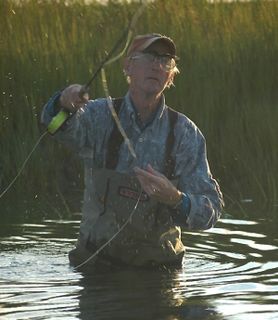
John Clarence "Jack" Gartside was an American fly tyer and fly fishing author.

Fly tying is the process of producing an artificial fly used by fly fishing anglers to catch fish. Fly tying is a manual process done by a single individual using hand tools and a variety of natural and manmade materials that are attached to a hook. Although the recent history of fly tying dates from the middle 1800s, fly tyers were engaged in tying flys since at least 200 AD.

The Woolly Bugger is an artificial fly commonly categorized as a wet fly or streamer and is fished under the water surface. It is a popular and widely used pattern for both freshwater and saltwater game fish and is generally listed as one of the top patterns to have in any fly box. John Gierach, a noted fly fishing writer discussed the Woolly Bugger first in his chapter on streamers in Good Flies. Woolly Buggers are typically fished in streams, rivers, ponds, lakes, and tidal flats. Today, Woolly Buggers are tied in a wide variety of styles and colors to imitate a wide range of game fish prey.
The Woolly Bugger is so effective, it should be banned from some watersheds. I suspect its effectiveness is due to its resemblance to so many edible creatures in the water—nymphs, leeches, salamanders, or even small sculpins. Its tail undulating behind a fiber, bubble-filled body is just too much for most fish to resist. It just looks like a meal!

The Muddler Minnow is a popular and versatile artificial fly of the streamer type used in fly fishing and fly tying.

The Clouser Deep Minnow is an artificial fly commonly categorized as a streamer and is fished under the water surface. It is a popular and widely used pattern for both freshwater and saltwater game fish and is generally listed as one of the top patterns to have in any fly box, especially for bass and saltwater flats fishing.

An artificial fly or fly lure is a type of fishing lure, usually used in the sport of fly fishing. In general, artificial flies are an imitation of aquatic insects that are natural food of the target fish species the fly fishers try to catch. Artificial flies are constructed by fly tying, in which furs, feathers, thread or any of very many other materials are tied onto a fish hook.
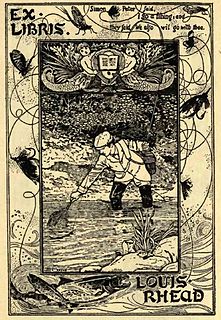
This general annotated bibliography page provides an overview of notable and not so notable works in the English language regarding the sport of fly fishing, listed by year of first publication. Although not all the listed books are devoted exclusively to fly fishing, all these titles contain significant fly fishing content. The focus of the present page is on classic general texts on fly fishing and its history, together with notable public or university library collections dedicated to fly fishing.
Bernard "Lefty" Kreh was an American fly fisherman, photographer and fly casting instructor who resided most recently in Hunt Valley, Maryland. Kreh is most known for being one of the pioneers of saltwater fly fishing and his book, Fly Fishing in Salt Water, is considered the seminal volume on the subject.
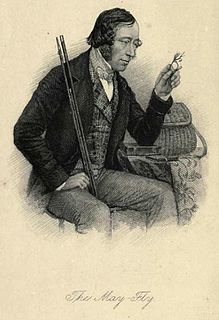
This annotated bibliography is intended to list both notable and not so notable works of English language, non-fiction and fiction related to the sport of fly fishing listed by year published. Although 100% of any book listed is not necessarily devoted to fly fishing, all these titles have significant fly fishing content. Included in this bibliography is a list of fly tying, fly tackle, regional guides, memoirs, stories and fly fishing fiction related literature.

The Elk Hair Caddis is a dry fly commonly used for trout fishing. The Elk Hair Caddis was created by Pennsylvania fly tyer Al Troth in 1957. He is considered a pioneer in the sport of fly fishing for this invention.

The Royal Wulff is a popular artificial fly used for dry fly fishing. It is an attractor pattern and a descendant of both the Royal Coachman fly and the Wulff style of hair wing flies named for Lee Wulff.
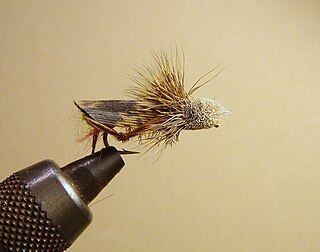
Dave's Hopper is an artificial fly used for fly fishing, designed to imitate adult grasshoppers and other Orthoptera species. It is considered a dry fly terrestrial pattern. It was designed by fly tyer and angler Dave Whitlock, and combines the best aspects of Joe's Hopper and Muddler Minnow patterns.
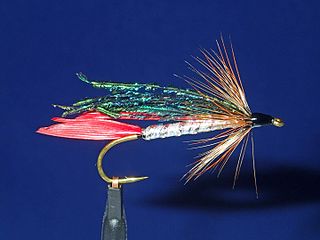
The Alexandra wet fly originated in Scotland in the 1860s. The artificial fly is also known as the Lady of the Lake, the fly was named by English angler Major William Greer Turle to honor Alexandra, Princess of Wales. The fly is distinguished by the heavy peacock herl wing and silver body which makes the fly resemble a small baitfish or fry. The Alexandra proved to be a very effective fly for trout in lakes and streams in England and Scotland in the late 19th and early 20th century. Many fly fishing purists derided the fly and its use was once banned on many English waters.

A tube fly is a general tying style of artificial fly used by fly anglers. Tube flies differ from traditional artificial flies as they are tied on small diameter tubes, not hooks. Tube flies were originated in Aberdeen, Scotland by fly-dresser Minnie Morawski for Atlantic salmon anglers around 1945. Tube flies were designed to improve hooking success and to prevent damage to complex and expensive salmon flies by the teeth of hooked salmon. Tube flies have been widely adapted to fly patterns for a variety of cold water and warm water species and are extremely popular for steelhead and salmon in the Pacific Northwest and northeast United States, as well as saltwater species along the Atlantic, Florida and Gulf Coasts. They are widely used in European waters for Atlantic salmon, sea trout and pike.
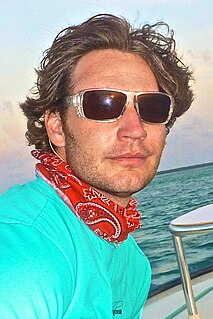
Andrew "Drew" Chicone is an American author, saltwater fly designer, fly fisherman and fly casting instructor. He writes books and magazine articles demonstrating how to tie saltwater fly patterns, primarily focused on warm-water fish and fly fishing from standup paddleboards.

The Lefty's Deceiver is an artificial fly streamer pattern used in fly fishing for freshwater and saltwater species. The fly was originated by fly angler and author Lefty Kreh in the Chesapeake Bay for striped bass. The original fly was tied to resemble smelt, a common striped bass forage. The Deceiver is arguably the best known saltwater fly pattern in the world and in 1991 the U.S. Postal Service honored Kreh’s creation with a postage stamp.

The Crazy Charlie is a bonefish fly for saltwater fly fishing developed on Andros Island in 1977 in the Bahamas by local bonefish guide Charlie Smith and popularized by San Francisco angler Bob Nauheim. They fly was developed to imitate glass minnows, a common forage for bonefish on the nearshore flats of south Florida and Caribbean islands. The Crazy Charlie has become a staple fly for bonefish and permit anglers around the globe.

The Humpy fly is a popular and effective dry fly used by fly anglers for trout in fast-water conditions.
This page is based on this
Wikipedia article Text is available under the
CC BY-SA 4.0 license; additional terms may apply.
Images, videos and audio are available under their respective licenses.
























